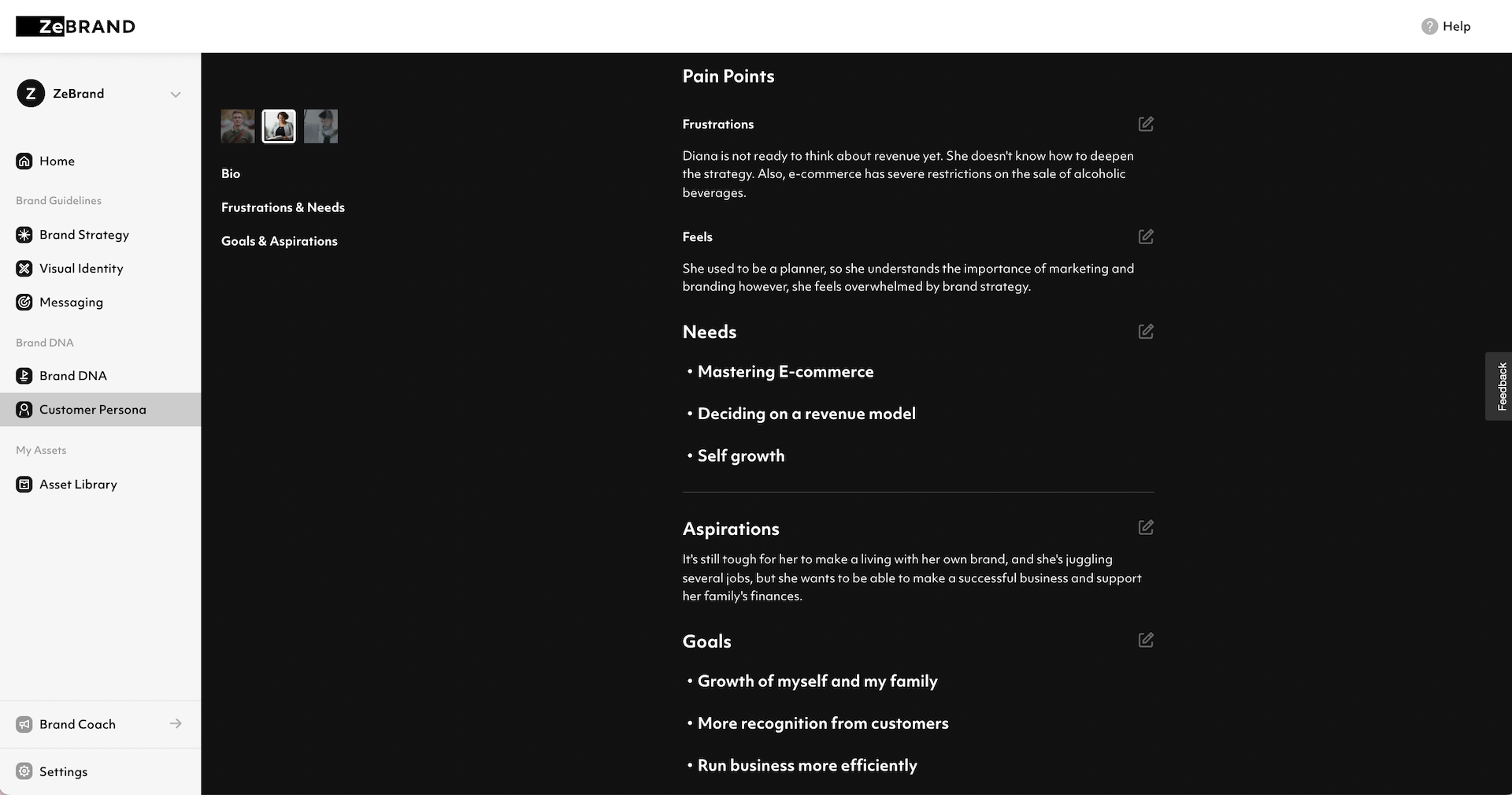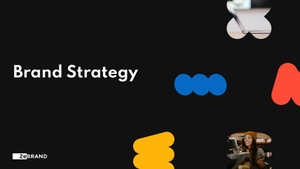Group Branding Session: Knowing your Customer Persona

Sign-up for ZeBrand and join our next group branding session!
-
- What is the most useful way of using this persona when thinking about marketing plans or business strategies?
- Can you give me a bad example?
- How can branding help your business succeed?
- Can you tell me what a brand strategist is and what you do?
- How often or when should we reconsider our own branding and brand strategy?
- What's the difference between branding strategy, marketing strategy, and business strategy?
This webinar has been edited for brevity and clarity.
If you are familiar with the traditional branding process, you know, it could take a long time and can require a large budget. As our mission is to enable you to brand your way. We want to provide you with the optimal environment for all your branding needs.
To do this, we've broken down the process to define, design, and deliver your brand. It's about knowing what your brand is about, who you want to deliver it to, and how to do it. And then you design your visual identity, and finally, deliver your brand to the world.
But as you see the process never ends because you can only know how your audience would feel about your brand. Once you deliver it. It is necessary to always be aware of how your brand is perceived by your audience and just if needed, and also the environmental changes are so fast these days, your audience to behavior changes quite often. That leads us to our topic today, which is customer persona.
We talked with Zachary Lamb, a brand strategist with experience in various sectors, about all things related to knowing your customer persona.
1. What is a customer persona?
A customer persona is usually a one-page simplification that gives an overview of your ideal target customer. Then, it brings them to life. For example: how they think and feel, their pain points, and demographically - how old they are and where they live.
It's a snapshot portrait of who your ideal customer is. That's both for yourself and the brand. A customer persona guides you to know who you're messaging for, and it helps potential investors understand what you know and who you're targeting. Critically, it needs to go beyond just demographics. The goal is to understand your customer psychologically and how your branded product can appeal to that person's mindset. So the customer persona keeps your brand grounded and on track to serve and solve the problems for a specific kind of person.
2. Why do I need a customer persona?
It's imperative to be for somebody and not for everybody.
If you try to make your brand appeal to everybody, the result will be too big and not as sharp and emotionally resonant as it needs to be.
The customer persona lets you know how your brand shows up in the world and how your messaging should feel and sound.
When you have a keen understanding of who you will be talking to, you know how to guide the copy, tone, and visual appearance toward your persona, so it's essential to have that specific type of person you're looking for in mind.
Otherwise, you'll end up sounding more generic than you need to be. Customers want brands and products that speak to who they are as people. So when they encounter your brand, you want them to go, "oh yeah, that's that's for me." That's when you know that you've got it right.
The customer persona can guide you to where the tone of voice to the look and feel of the brand presentation is sharpened for a particular kind of person in mind.
3. When is it important to decide on customer personas?
Well, you know, tomorrow was yesterday. So as soon as you can. The customer persona is one of the most foundational pieces of the define stage.
It's okay if you don't have everything as detailed as you like, you can always revise later as it's a process that never ends.
It's a circular process, but it's essential to have that North star vision and that North star customer that guides you and shapes your brand so you can appeal to that person as soon as you can.
Even if you've already done a lot for the brand in the business, it's never too late to add the customer persona and start to sharpen it, especially when you get to that deliver stage because that's when you're providing the messaging honed in for the particular person in mind.
4. How do you identify your customer persona?
The starting point is yourself. You started your brand because you were passionate about something. You wanted to solve a problem in the world, you saw a need, and you wanted to start a business to solve it.
So unpack that passion and think about the kind of person that would share the same vision that you have. Why does your business exist? Who's going to be motivated by that same problem that you're solving? What is the mindset of the person interested in the same things that interested me when I was starting this? So first, you have to articulate that.
Then after you've done this, you start talking to people you think your brand is for. That could be online, but ideally, it's in person. There's no substitute for sitting down and hearing from them, in their own words, to help you better understand what makes them tick and the kind of things they value in the world. Those could even be friends; if you think they're like your target customer, there's nothing wrong with that. Just get out in the world and talk to people.
It's also important to read things that might be relevant to your target audience. Take COVID-19, for example, which dramatically changed the culture. So it's crucial to understand how large cultural forces affect the day-to-day lives of your target audience because that's going to be shaping their aspirations and pain points, their needs and wants, and ultimately the problems that your brand is solving.
When you've got a good understanding of those things, you've talked to some people, you've done some reading online, you've done some research, and it's time to sit down and start to put pen to paper. Start to define your customer persona, and we have a template that we'll show you in a little bit for that.
Not everything needs to be perfect because you're not modeling a real person. I think that's key. It's an idealized portrait. It's a persona made up of your conversations with lots of people. So you start to generalize and average the variables for each of the things on the persona template.
5. How do you write a customer persona? What information should be included?

This is an example of ZeBrand's Customer Persona module. It's good to have a picture of who you think the person is. Give an age range, the basic demographic information, where they might live, what gender, what do they do for a job? Do they have a family? Do they have pets? Paint a picture of their world.
We also have these personality gauges, which are nice because you can infer a lot about who the person is. For example, are they introverted versus extroverted or analytical versus creative? It's good to get to that level of detail because we're trying to capture them psychologically.

Next, think through the Frustrations & Pain Points section. Ideally, your brand is solving a problem for people, so you want to hone in on the pain point that your brand and products are solving. What do they generally feel about the category/industry you're in? What do they need in their life that you and your brand can solve for them?
Finally, Aspirations & Goals are one of the most important sections of the persona. What is it about this person that's pulling them into their future? What are they excited about? What are they hopeful for? What are they looking forward to in the future? As I mentioned before, you want somebody to encounter your brand and go, "Oh, yeah, that's a brand for me."It's how somebody sees themselves. So you want the emotional center of your brand to come from this Aspirations & Goals section of the persona.
As you can see, it's a one-page well-rounded picture of who your customer is that you can use to guide your brand and share with potential investors.
Q&A Session
What is the most useful way of using this persona when thinking about marketing plans or business strategies?
For marketing plans, the persona informs the tone your communications should take. Should I communicate seriously or maybe lightheartedly? It helps you choose the tonal implications. Also, when you think about a marketing plan, you want to know where this person spends their time. Are they on Instagram all the time? Are they on Twitter all the time? You can utilize your persona to decide where you would put your communications.
Can you give me a bad example?
A bad example would be only to have filled out the demographic portion of the persona and have nothing about what the person thinks and feels or about their aspirations and goals.
When you think about your favorite brands, like Nike or Apple, they've got a strong emotional resonance to them that connects to people's aspirations. Everybody can be an athlete, get out there, and just do it. It's motivating. And it helps people see themselves in a positive light, so they want to be a part of that Nike community. Apple is this innovative and future-forward thing, so if I want to see myself as innovative and future-forward, then I want to use an Apple product as a result.
So a bad example does not have Aspirations & Goals filled out. I don't know about what's going on inside their head. I don't know much about what makes them tick. So it's really important to push for that aspirational and emotional piece. That's why I recommended getting out and talking to people earlier because that's when you'll be able to start to understand this and feel it, which is essential for crafting a brand.
How can branding help your business succeed?
Branding can help your business succeed because branding is really what connects people emotionally to your brand. Let's say you're selling t-shirts. Do you want a plain white t-shirt, or do you want a t-shirt that's from a brand that means something, or maybe it's sustainably sourced? Perhaps it's got a premium kind of cotton? Maybe it's a woman-owned business? Branding is all the extra stuff that's emotionally surrounding your business that people can connect with, grab onto, and really, really care about. It's the more emotional presentation of what your business actually is, as well as a designed presentation. So it's not just a visual, but the story behind it. I always encourage people that I work with to think about their favorite brands in their life, and their favorite brand is always something like Nike that's got a strong emotional center to it. And you know, that's what branding is. That's why you love that brand. Not only do they have a great product or service, but they also deliver that product and service in a special way that has a value set connected to it.
Can you tell me what a brand strategist is and what you do?
A brand strategist is somebody that's the voice of the consumer, the voice of the person. Their job is to understand the customer target inside and out. What makes this person tick, as well as understand all the cultural forces that are surrounding that person. To understand what category and competitive context the business is playing in. Who are the competitors, and how are they branding themselves? How do we brand ourselves differently to stand out from our competitors? Then put all those pieces together like an equation.
So here's our customer mindset, our customer persona plots what's happening in the competitor category. Plus, you know, all the cultural forces and your business goals. You add all that up and translate it into a growth strategy that you use to propel your brand forward.
ZeBrand users want help focusing on who their customer is. Or sometimes it's more about how I stand apart from my competition? How do I roll all that up into what my brand story is? How will my brand idea be unique so that it stands out? Of course, users have different needs across the board, but a brand strategist's job is to knit all those pieces together in a way where you can tell a unique story about your brand that stands out and differentiates you from your competition.
How often or when should we reconsider our own branding and brand strategy?
There's no easy answer to that question. You'll know when you know. Ideally, you'll do a good job upfront to get you going, but then you might find I might need to tweak something, so let me reevaluate a little bit.
Often, its culture will change, and brands will get left behind. However, ZeBrand users are just beginning, so I think the task is to define everything upfront versus worrying about change.
Look at COVID-19; you've seen how brands have changed a little bit as a result. They're talking about themselves a little bit differently, maybe emphasizing things like community and coming together and connecting in ways they weren't before.
More often than not, the brand's core DNA is why I exist, which usually doesn't change. What does change is the marketing communication, the presentation of why to keep up with the culture.
What's the difference between branding strategy, marketing strategy, and business strategy?
Business strategies are "I need to sell this many units in this amount of time," or "I need to take my market awareness numbers from 10% to 15% in this amount of time". So business goals are on that level of market share, sales, volume, user signups, things of that nature. So what are my hard and fast business goals?
Brand strategy is how you express yourself in a unique and differentiated way. Considering who your customer is, what they care about, what they aspire to, and what they value. Get a good sense of your customer and add that to the competitive set that you're up against. You don't want to sound and be like somebody else because that already exists. It's critical to stand out. So a brand strategy is how I make what's unique about my brand, the "why I exist," to the center of my brand. How do I position my emotional core and shape that in a way that's different and helps me stand out?
Then the marketing strategy is okay, I've got my brand strategy, I've got my business goals, well, where should I put my marketing? You know, does it make sense to be on Facebook, Twitter, and Instagram? Or does it make sense to go to events in the real world and hand out things? So the marketing strategy is my strategy for getting my message out into the world. So it's more a channel strategy, is it digital, social, etc.


